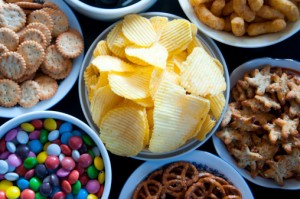Top Five Tips for Handling Emotional Eating and Cravings
The connection between food and mood for humans is generally immense. We eat to celebrate; we eat if we feel sad; we eat to ‘reward’ ourselves; we eat because someone gives us something and we feel ‘obliged’. Ironically, we rarely seem to eat simply to fuel the physical body. Yet we tend to so rarely discuss our strong emotional connections to food. Some people may never even have given it a thought.
At the same time, many people feel that they struggle with cravings for foods they don’t truly want to eat, or they hanker for excessive amounts of food. Why do cravings happen? Well, a big reason of course is that until you remove the ‘foods’ that are highly physiologically addictive (such as processed starches and refined sugars) from the intake completely, they remain in your system and you stay addicted. Beyond the physiological addiction, however, there is much more to consider: the psychological aspects.
Most of us form emotional associations with food at a very young age. Children are routinely given food to pacify them, cheer them up, reward them and so on. This creates strong psychological bonds between our feelings and our food. Children are often coerced into eating when they’re not hungry, finishing meals ‘to make Mummy happy’ and so on. Eating thus becomes a way of getting approval and finding comfort and happiness. It is mostly a false kind of happiness though, when examined more closely. Far from bringing genuine joy, the child gets hooked into life-long patterns of ‘using’ foods that are potentially damaging. There is a genuine joy in life far sweeter than any candy bar, which we can all access at any moment simply by choosing to pay attention to our true feelings and coming into alignment with what is ‘natural’, i.e., nature.
When one adopts a lifestyle rich in fresh raw foods (like I did back in May 2002, releasing 160 pounds of excess fat as a result), the common addicted relationship with food can change dramatically, as we’re no longer taking in toxic, processed foods that are physiologically addictive and cause the most damage - thus, half the ‘battle’ is already won. Changing what you eat can make a great deal of difference. However, the eating patterns we have established with food over many years - for comfort, excitement, reward and so on - do not simply vanish overnight, just by going raw.
It is common to find people still acting out self-destructive patterns around food decades into life. For example, you might see a fifty-year-old woman still diving for the ice cream tub every time she feels hurt. Once embedded, these patterns can be tough to shift.
We tend to crave familiarity and the sense of comfort that eating those ‘binge’ foods brings. The cravings are a reflection of the associations in our heads between food and comfort. However, those associations have as much validity as we choose to give them. They can be restructured at any time, with new thought patterns, beliefs, choices and actions. The more you keep moving into new patterns, the less the old cravings will affect you. They fade with time and consistency.
Let’s take a look at five top tips to help you re–structure your emotional relationship with food, taken from my book ‘Raw Emotions’:
1. ‘Head Hunger’ vs. ‘True Hunger’.
When we get the impulse to eat something, we often assume it’s the stomach talking rather than the mind. However, try asking yourself this: do you really ‘need’ this food that you desire, to be physically nourished and well? Or is it just your mind asking for something to distract itself with, for emotional satisfaction?
Try reflecting on what it is that you want to eat. When we are truly hungry, we usually feel like we could eat anything (of course, usually within any pre-defined dietary boundary, such as ‘any raw vegan food’ for a raw vegan, for example). If, on the other hand, your hunger is directed specifically at ‘that’ piece of raw carrot cake (for example) and you’re not really interested in anything else, this suggests that the hunger is coming more from the mind. The mind wants to have the experience of eating that cake, even if your physical body isn’t really ready for it. Remember: what the mind wants isn’t necessarily beneficial for the body.
You can gently ask yourself: when did I last eat? Has that food digested yet? Do I genuinely feel a sense of ‘pulling’ and emptiness in my stomach? Would I eat something else right now, other than what I’m thinking of eating? Remember that cravings come and go; this too shall pass. Instead of jumping in with a knee-jerk response to a craving, we can step back and ask ourselves a few quick questions like this, to gain a clearer perspective on what’s happening.
2. Drink Water & Teas
Often, what we’ve learned to interpret as hunger is, in fact, thirst. Most people are chronically dehydrated. Whenever you feel hunger or cravings, make it a habit to drink at least a full glass of pure water. You may find that the hunger/craving vanishes… Other ‘phantom’ hungers can result from eating lots of fatty/salty foods or foods that have not digested well; we might get odd sensations in our physical body that we interpret as hunger. Again, if we wait for a while or drink some water, we’ll commonly find that these sensations dissipate.
Drinking warm teas can also be very useful for pacifying emotional hunger/cravings. Reaching for a cup of warm, caffeine-free, herbal tea as an alternative to any ‘Trigger’ foods, can help you to feel that sense of warmth, comfort and satisfaction, without the burden of a food binge. This is especially useful if you are in a cold climate, plus it’s extra hydration for the body and can bring the bonus of some great nutrients. I recommend teas such as ginger to warm, rooibus or peppermint to soothe, pau d’arco for anti-candida properties and so on. Some raw foodists don’t drink warm teas, for the same reason they don’t eat warmed foods. I like warm tea though and feel it’s a useful tool for certain times; perhaps just don’t use boiling hot water.
3. Reach Out to Others
If you’re on the brink of a binge, try reaching your hand towards the phone, rather than the fridge door. Speaking with someone else about what is happening for us can make all the difference, helping us to step outside the circles in our heads. A phone may not even be necessary; maybe at the end of a meal with a loved one, you feel compelled to keep eating. Expressing your feelings about this may help you to end the meal then, rather than ‘acting out’ and eating more than you’d intended.
When we are isolated in our own thoughts, patterns and perspective, it’s easy to go in negative circles in our heads focusing on ‘problems’. Extrovert: reach out to others, get active, get involved, get out of your head and into your heart.
I highly recommend seeking out connection with others who resonate with the experiences you’re having, especially sharing together in a group circle setting. An issue pondered in isolation can seem immense, whereas sharing that same issue with others who understand, may help make it seem not only manageable, but also easier to transform. There are many local support groups where you can find loving encouragement and also plenty of online resources for connecting to like–minded others (see www.therawfoodworld.com/ic for example).
4. End of Meal Activities
Having activities planned for immediately after eating can be a great incentive for ending a meal. This doesn’t necessarily need to involve physical activity, just something to help draw you away from thoughts of eating more - perhaps a phone call to a friend, tidying up a drawer or writing a letter. Planning activities that are far away from the kitchen/location of food in your home is a good idea.
Reinforce good feelings about your choices by thinking to yourself with gratitude at the end of a meal something such as, ‘Wow, what a feast that was’, rather than the common ‘Well…that’s it, I guess…’ that many food addicts dread. This helps in situations when you’ve finished what you intended to eat and your mind seems to be asking for more.
Here’s another simple tip if you find it hard to stop eating after a meal: brush your teeth and you’re less likely to want to keep eating, with a mouth full of minty-fresh whites...
Keeping our fingers and/or teeth ‘busy’ with something other than eating can help us to not binge too. You might employ your fingers, for example, in some knitting, puzzle-work or plant-tending. Chewing on raw licorice sticks or sugar cane stalks might keep your teeth entertained. You can also purchase ‘jaw exercisers’ that help keep your mouth engaged, while simultaneously strengthening your jaw and teeth. If our fingers and teeth are already involved in activity, we might find we’re less likely to reach out for food.
5. Journalling
Use the power of the written word to help keep you on track. If you’re feeling low about your eating habits, get pen to paper and write down exactly what you’re feeling and thinking, right then. Similarly, at points when you’re feeling very clear and focused about your eating (often first thing in the morning), make notes - what are you feeling at this point? What are you thinking? What are you eating these days? What are you not eating? How much water do you drink? These written notes can be invaluable if you find yourself in a sticky place with your food choices again. In challenging moments, you can refer to these notes for a bigger perspective on your patterns and hopefully find the inspiration to stay on track.
Another useful exercise to try when you are in a clear, steady space, is to do some writing about overeating. How does overeating seem when you are in this balanced state? Making such notes might help you to start feeling more like an ‘observer’ of the often impulsive and irrational action of overeating. It can even seem absurd to contemplate overeating when we are in that space of stillness and calmness. The more we can separate ourselves from that impulsiveness, the less likely we are to act out, when we next feel the pull to overeat.
You may also find it useful to use visual cues in your journal, such as old photos of yourself, a picture that captures your optimal vision for your life, grocery receipts or anything else that helps inspire you to stay on track.
I hope these tips have given you some ‘food for thought’; remember, we have a choice in every moment. Just because we may have consistently used food as our ‘safety net’ in the past does not mean we must continue to do so now. We are always free to restructure our relationship with food…and whatever issue you may be dealing with in life, unless it is true physical hunger, the answer is not in the fridge ;)
–––––––––––––
Award-winning author Angela Stokes lost an amazing 160lbs with a raw lifestyle, reversing morbid obesity. Her most recent book ‘Raw Emotions’ explores raw food transformations beyond the physical level.
30-year-old Angela went raw in May 2002 and her life has since dramatically transformed. Her website, www.RawReform.com shares her amazing story of recovery, along with guidance and inspiration for others. She shares videos, before/after pictures and also blogs almost daily (http://rawreform.blogspot.com). Angela offers books, retreats, consultations and lectures internationally on raw foods.
-
Evoke The Massive Power Of The Subconscious Mind
Inside your mind, behind the defences of the rationale brain and criti
-
Body Fat and Weight Loss - Are they Accurate?
How many times a week do you listen to t
-
Fast Weight Loss Ideas That You Must Know
A lot of us will want to have rapid loss. To this end, you will need t
-
The Secret to not Regain Lost Weight
The multibillion dollar weight loss business thrives on dieters’
-
Abs Diet Guidelines
More than any other areas of the body, the abs are the center of atten
-
How To Survive Thanksgiving Dinner While On A Diet
Its the dreaded time of the year,the foo
- DON'T MISS
- Does Lipoxinol Really Work
- Psoriatic arthritis vs. osteoarthritis, differences in symptoms, causes, and treatment
- 5 Health Signs Men Ignore At Their Own Cost
- What Are Weight Loss Pills?
- Problems With Popular Diets
- How We Can Know the Best Weight Loss Diet Plan - The Calorie Shifting Diet Plan
- Increase Your Metabolism and Lose Weight
- How to Lose Weight on a Budget
- The Third of Seven Sins in Obesity - Dehydration
- How To Avoid The Fat Demons




